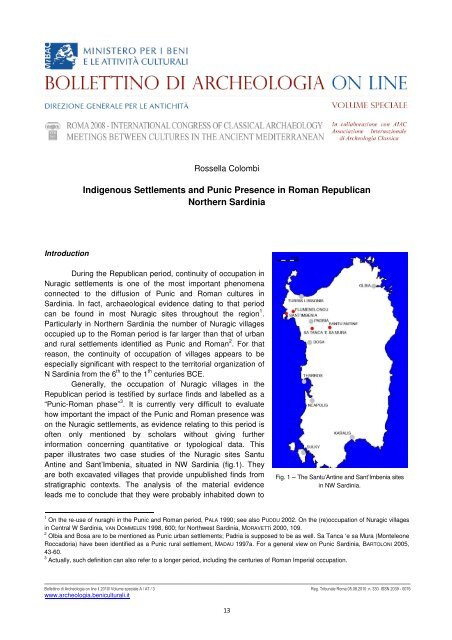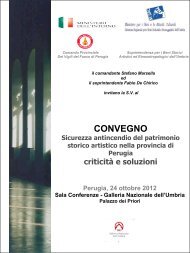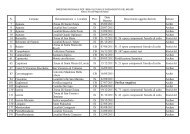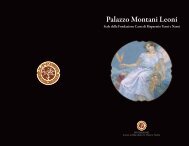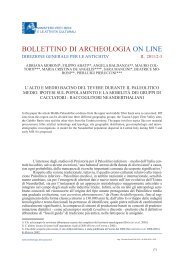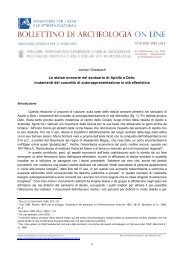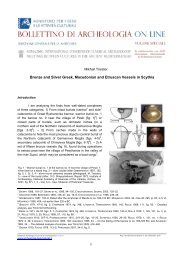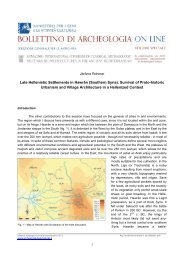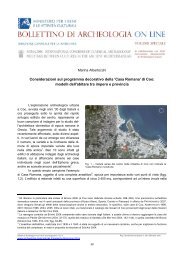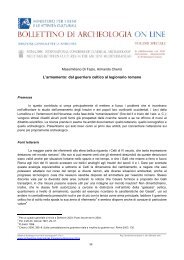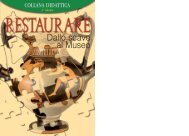Indigenous Settlements and Punic Presence in Roman Republican ...
Indigenous Settlements and Punic Presence in Roman Republican ...
Indigenous Settlements and Punic Presence in Roman Republican ...
You also want an ePaper? Increase the reach of your titles
YUMPU automatically turns print PDFs into web optimized ePapers that Google loves.
Introduction<br />
Rossella Colombi<br />
<strong>Indigenous</strong> <strong>Settlements</strong> <strong>and</strong> <strong>Punic</strong> <strong>Presence</strong> <strong>in</strong> <strong>Roman</strong> <strong>Republican</strong><br />
Northern Sard<strong>in</strong>ia<br />
Dur<strong>in</strong>g the <strong>Republican</strong> period, cont<strong>in</strong>uity of occupation <strong>in</strong><br />
Nuragic settlements is one of the most important phenomena<br />
connected to the diffusion of <strong>Punic</strong> <strong>and</strong> <strong>Roman</strong> cultures <strong>in</strong><br />
Sard<strong>in</strong>ia. In fact, archaeological evidence dat<strong>in</strong>g to that period<br />
can be found <strong>in</strong> most Nuragic sites throughout the region 1 .<br />
Particularly <strong>in</strong> Northern Sard<strong>in</strong>ia the number of Nuragic villages<br />
occupied up to the <strong>Roman</strong> period is far larger than that of urban<br />
<strong>and</strong> rural settlements identified as <strong>Punic</strong> <strong>and</strong> <strong>Roman</strong> 2 . For that<br />
reason, the cont<strong>in</strong>uity of occupation of villages appears to be<br />
especially significant with respect to the territorial organization of<br />
N Sard<strong>in</strong>ia from the 6 th to the 1 th centuries BCE.<br />
Generally, the occupation of Nuragic villages <strong>in</strong> the<br />
<strong>Republican</strong> period is testified by surface f<strong>in</strong>ds <strong>and</strong> labelled as a<br />
“<strong>Punic</strong>-<strong>Roman</strong> phase” 3 . It is currently very difficult to evaluate<br />
how important the impact of the <strong>Punic</strong> <strong>and</strong> <strong>Roman</strong> presence was<br />
on the Nuragic settlements, as evidence relat<strong>in</strong>g to this period is<br />
often only mentioned by scholars without giv<strong>in</strong>g further<br />
<strong>in</strong>formation concern<strong>in</strong>g quantitative or typological data. This<br />
paper illustrates two case studies of the Nuragic sites Santu<br />
Ant<strong>in</strong>e <strong>and</strong> Sant’Imbenia, situated <strong>in</strong> NW Sard<strong>in</strong>ia (fig.1). They<br />
are both excavated villages that provide unpublished f<strong>in</strong>ds from<br />
stratigraphic contexts. The analysis of the material evidence<br />
leads me to conclude that they were probably <strong>in</strong>habited down to<br />
1<br />
On the re-use of nuraghi <strong>in</strong> the <strong>Punic</strong> <strong>and</strong> <strong>Roman</strong> period, PALA 1990; see also PUDDU 2002. On the (re)occupation of Nuragic villages<br />
<strong>in</strong> Central W Sard<strong>in</strong>ia, VAN DOMMELEN 1998, 600; for Northwest Sard<strong>in</strong>ia, MORAVETTi 2000, 109.<br />
2<br />
Olbia <strong>and</strong> Bosa are to be mentioned as <strong>Punic</strong> urban settlements; Padria is supposed to be as well. Sa Tanca ‘e sa Mura (Monteleone<br />
Roccadoria) have been identified as a <strong>Punic</strong> rural settlement, MADAU 1997a. For a general view on <strong>Punic</strong> Sard<strong>in</strong>ia, BARTOLONI 2005,<br />
43-60.<br />
3<br />
Actually, such def<strong>in</strong>ition can also refer to a longer period, <strong>in</strong>clud<strong>in</strong>g the centuries of <strong>Roman</strong> Imperial occupation.<br />
Bollett<strong>in</strong>o di Archeologia on l<strong>in</strong>e I 2010/ Volume speciale A / A7 / 3 Reg. Tribunale Roma 05.08.2010 n. 330 ISSN 2039 - 0076<br />
www.archeologia.beniculturali.it<br />
13<br />
Fig. 1 – The Santu’Ant<strong>in</strong>e <strong>and</strong> Sant’Imbenia sites<br />
<strong>in</strong> NW Sard<strong>in</strong>ia.
R. Colombi - <strong>Indigenous</strong> <strong>Settlements</strong> <strong>and</strong> <strong>Punic</strong> <strong>Presence</strong> <strong>in</strong> <strong>Roman</strong> <strong>Republican</strong> Northern Sard<strong>in</strong>ia<br />
the 1 st century BCE. Furthermore, my analysis contributes to the def<strong>in</strong>ition of the chronology of these two<br />
important sites <strong>in</strong> the <strong>Punic</strong> <strong>and</strong> <strong>Roman</strong> <strong>Republican</strong> period.<br />
Santu Ant<strong>in</strong>e Nuragic Village<br />
The village is located <strong>in</strong> a fertile pla<strong>in</strong> area of the Meilogu region (<strong>in</strong>ner NW Sard<strong>in</strong>ia), abound<strong>in</strong>g <strong>in</strong><br />
rivers <strong>and</strong> spr<strong>in</strong>gs (fig. 2). The nuraghe was first excavated <strong>in</strong> the 1930’s <strong>and</strong> some squared rooms were<br />
discovered <strong>in</strong> the SE sector of the village, these were identified as a ‘villa rustica’ dat<strong>in</strong>g to the mid-late<br />
Imperial period 4 . The surround<strong>in</strong>g village was repeatedly <strong>in</strong>vestigated <strong>in</strong> 1960’s, 1980’s <strong>and</strong> 1990’s 5 . The<br />
latest excavation campaign took place <strong>in</strong> 2003-2004 <strong>in</strong> the western sector of the Nuragic village; <strong>in</strong> the<br />
meantime, dur<strong>in</strong>g a conservation project <strong>in</strong>volv<strong>in</strong>g the nuraghe, a few limited areas <strong>in</strong>side the monument<br />
were excavated 6 .<br />
To sum up, two ma<strong>in</strong> chronological phases have been identified at Santu Ant<strong>in</strong>e: the first one dat<strong>in</strong>g<br />
from the construction (15 th century BCE) to the ab<strong>and</strong>onment of the nuraghe (10 th - 9 th century BCE),<br />
probably due to a partial collapse of the structure; the second one testifies the occupation of the village from<br />
4 TARAMELLI 1939, 65-6.<br />
5 CONTU 1988, 7-12; BAFICO ET AL. 1997b.<br />
6 CAMPUS 2006, 65-72.<br />
Fig. 2 – Santu Ant<strong>in</strong>e Nuragic village; left, the area excavated <strong>in</strong> 2003-2004<br />
(modified from CONTU 1988, fig. 7; <strong>and</strong> PIANU 2006, fig. 69).<br />
Bollett<strong>in</strong>o di Archeologia on l<strong>in</strong>e I 2010/ Volume speciale A / A7 / 3 Reg. Tribunale Roma 05.08.2010 n. 330 ISSN 2039 - 0076<br />
www.archeologia.beniculturali.it<br />
14
XVII International Congress of Classical Archaeology, Roma 22-26 Sept. 2008<br />
Session: Colonis<strong>in</strong>g a Colonised Territory<br />
the F<strong>in</strong>al Bronze (12 th century BCE) to the 4 th century CE 7 . Besides the Nuragic phase, the <strong>Roman</strong> period<br />
was also emphasised, through specific structures such as the rural villa excavated by Taramelli <strong>in</strong> 1933 <strong>and</strong><br />
the storehouses located <strong>in</strong> the northern sector, dat<strong>in</strong>g to the Imperial period 8 .<br />
Despite the number of field <strong>in</strong>vestigations carried out at Santu Ant<strong>in</strong>e, both overall studies<br />
concern<strong>in</strong>g the nuraghe <strong>and</strong> its village <strong>and</strong> <strong>in</strong>tegral editions of f<strong>in</strong>ds are still lack<strong>in</strong>g. Concern<strong>in</strong>g this, most<br />
scholars compla<strong>in</strong> that the greater part of material evidence found <strong>in</strong> the former excavations does not come<br />
from stratigraphical contexts. This is also true for the selection of imported ceramics dat<strong>in</strong>g from the 8 th<br />
century BCE to the <strong>Roman</strong> period, published <strong>in</strong> 1988 by Madau <strong>and</strong> Manca di Mores 9 . The uncerta<strong>in</strong><br />
provenance of these <strong>and</strong> similar ceramics at Santu Ant<strong>in</strong>e has meant that they have been only stressed for<br />
their chronological <strong>and</strong> geographical values. In fact, they are ma<strong>in</strong>ly considered as proof of the cultural<br />
contacts <strong>and</strong> exchanges that may have affected the Nuragic settlement throughout most of the 1 st millenium.<br />
Start<strong>in</strong>g from the results of the former archaeological <strong>in</strong>vestigations, the 2003-2004 campaign aimed<br />
at excavat<strong>in</strong>g the Nuragic structures, <strong>and</strong> analys<strong>in</strong>g the material evidence altogether. Excavations were<br />
carried out on three circular huts (12-14) of the Nuragic village as well as a few squared rooms <strong>and</strong> straight<br />
walls (possibly relat<strong>in</strong>g to the village modifications carried out <strong>in</strong> the <strong>Roman</strong> period). Both of these were <strong>in</strong><br />
the western sector. Furthermore, the overall study of the ceramic f<strong>in</strong>ds was <strong>in</strong>itiated 10 .<br />
Even if still <strong>in</strong>complete, the ceramic analysis has provided a further contribution to the historical<br />
reconstruction of the village’s life, particularly dur<strong>in</strong>g the <strong>Roman</strong> <strong>Republican</strong> period. Firstly, the huts of the<br />
western sector appear to have been modified by build<strong>in</strong>g straight walls <strong>and</strong> squared rooms dur<strong>in</strong>g the first<br />
half of the 2 nd century BCE; secondly, this sector of the village demonstrates cont<strong>in</strong>uous occupation only<br />
until the mid-1 st century BCE, as testified by the absence of sigillata italica.<br />
Moreover, the analysis of ceramics found at Santu Ant<strong>in</strong>e <strong>in</strong> mid-late <strong>Republican</strong> contexts has<br />
shown that Nuragic pottery dom<strong>in</strong>ates until the 2 nd century BCE when compared to both <strong>Punic</strong> <strong>and</strong> <strong>Roman</strong><br />
ones 11 . The presence of <strong>Punic</strong> pottery <strong>in</strong> <strong>Republican</strong> contexts appears to be less significant for the amount<br />
of fragments than was expected. In fact, only ten <strong>Punic</strong> amphorae fragments dat<strong>in</strong>g to the 5 th - 2 nd centuries<br />
BCE 12 <strong>and</strong> one fragment of a black-glaze guttus probably produced <strong>in</strong> SW Sard<strong>in</strong>ia between 350-250 BCE 13 ,<br />
have been identified 14 . Unlike the published material from the previous excavations, evidence from the<br />
2003-2004 campaign has not revealed ceramics between the 8 th <strong>and</strong> the 6 th centuries BC 15 . F<strong>in</strong>ally, if we<br />
consider the total quantity of <strong>Punic</strong> sherds <strong>in</strong>clud<strong>in</strong>g some pla<strong>in</strong> <strong>and</strong> red b<strong>and</strong> decorated fragments <strong>in</strong> the<br />
mid-<strong>Republican</strong> contexts, it seems to be less relevant than the <strong>Roman</strong> ones; <strong>in</strong> fact, the ratio of <strong>Punic</strong><br />
pottery to <strong>Roman</strong> is 1:2 16 .<br />
In the period exam<strong>in</strong>ed (5 th - 4 th centuries BCE), archaeological evidence reveals that Santu Ant<strong>in</strong>e<br />
was <strong>in</strong>volved <strong>in</strong> trade networks <strong>in</strong>clud<strong>in</strong>g products from Central Italy <strong>and</strong> the northern Tyrrhenian area.<br />
Connections with the <strong>Punic</strong> area (S-SW Sard<strong>in</strong>ia <strong>and</strong> probably Sicily) seem to have occurred as well. In<br />
such a perspective, the lack of Attic or generally Greek ceramics at Santu Ant<strong>in</strong>e, except for the pre-Campana<br />
7<br />
CAMPUS 2006, 96-99.<br />
8 rd th<br />
These structures were excavated <strong>in</strong> 1990-1994 <strong>and</strong> partly dated to the 3 - 4 centuries CE, BAFICO ET AL. 1997b.<br />
9<br />
It <strong>in</strong>cludes 55 fragments on the whole, MADAU 1988, MANCA DI MORES 1988.<br />
10<br />
Prelim<strong>in</strong>ary <strong>in</strong>formation on the 2003-2004 excavation campaign is available, see PIANU 2006.<br />
11 th nd<br />
Referr<strong>in</strong>g to stratigraphies dat<strong>in</strong>g to the 4 - 2 centuries BCE, the percentage of Nuragic pottery varies from 88% to 55% of the total<br />
amount of sherds.<br />
12 th<br />
They can be partly identified as belong<strong>in</strong>g to the Maña B type, Bartoloni’s Forma B5 (5 century BCE). The fabrics of the rema<strong>in</strong><strong>in</strong>g<br />
fragments are similar to some amphorae from Terralba (Oristano) which result as hav<strong>in</strong>g been produced <strong>in</strong> Sicily, as suggested by P.<br />
VAN DOMMELEN (personal communication).<br />
13<br />
MOREL type 8114 a1.<br />
14 th th th<br />
The whole group of twenty fragments dat<strong>in</strong>g to the 5 - 4 century BCE also <strong>in</strong>cludes three fragments of Massaliote (4 century BCE)<br />
<strong>and</strong> Etruscan amphorae (Py type 4A, 450-250 BCE); six fragments of pre-Campana (Morel type 1122) <strong>and</strong> central-Italic black glaze<br />
pottery (Morel type 1111-1113, 1323, 1731, 2621). On the pre-Campana productions, MOREL 1981, 49.<br />
15<br />
Actually, the selection of 34 fragments from the 1960’s excavations published by Madau <strong>in</strong>cludes Eastern-Greek, Attic, Etrusco-<br />
Cor<strong>in</strong>thian <strong>and</strong> Phoenician-<strong>Punic</strong> ceramics, MADAU 1988.<br />
16 It has been estimated from one sample of different layers.<br />
Bollett<strong>in</strong>o di Archeologia on l<strong>in</strong>e I 2010/ Volume speciale A / A7 / 3 Reg. Tribunale Roma 05.08.2010 n. 330 ISSN 2039 - 0076<br />
www.archeologia.beniculturali.it<br />
15
R. Colombi - <strong>Indigenous</strong> <strong>Settlements</strong> <strong>and</strong> <strong>Punic</strong> <strong>Presence</strong> <strong>in</strong> <strong>Roman</strong> <strong>Republican</strong> Northern Sard<strong>in</strong>ia<br />
fragment, appears to confirm that the <strong>in</strong>digenous site had weaker relations with the eastern Mediterranean<br />
area <strong>in</strong> that period 17 .<br />
On the other h<strong>and</strong> Nuragic pottery appears to prevail over the imported vessels <strong>and</strong> persists<br />
throughout the <strong>Roman</strong> period. General conclusions that the <strong>in</strong>digenous community was transformed through<br />
the <strong>Punic</strong> expansion <strong>and</strong> later <strong>Roman</strong> conquest are not supported by the material evidence which suggests<br />
<strong>in</strong>stead more gradual <strong>and</strong> non traumatic changes.<br />
Fig. 3 – Black-glaze ware from Santu Ant<strong>in</strong>e, 3 rd -2 nd centuries BCE;<br />
d) <strong>Roman</strong> <strong>Republican</strong> lamp, 2 nd -1 st centuries B.C.<br />
(2003-2004 campaign; draw<strong>in</strong>gs by the Author).<br />
Bollett<strong>in</strong>o di Archeologia on l<strong>in</strong>e I 2010/ Volume speciale A / A7 / 3 Reg. Tribunale Roma 05.08.2010 n. 330 ISSN 2039 - 0076<br />
www.archeologia.beniculturali.it<br />
16<br />
Black Glaze Pottery (4 th – 1 st Centuries BCE)<br />
In the study of the Santu Ant<strong>in</strong>e<br />
<strong>Republican</strong> contexts, the analysis of blackglaze<br />
pottery 18 showed that it had a fundamental<br />
role <strong>in</strong> highlight<strong>in</strong>g cultural relationships<br />
<strong>in</strong>volv<strong>in</strong>g NW Sard<strong>in</strong>ia, particularly <strong>in</strong> the 3 rd -<br />
2 nd centuries BCE. Specifically, 36% of fragments<br />
have been identified as be<strong>in</strong>g produced<br />
<strong>in</strong> the half 4 th - 3 rd centuries BCE, while 57% is<br />
dated to the 2 nd century BCE <strong>and</strong> 7% to the 1 st<br />
century BCE.<br />
By the end of the 4 th century BCE,<br />
wares produced <strong>in</strong> the central-Italic area<br />
(Etruria, Latium) predom<strong>in</strong>ate <strong>in</strong> comparison to<br />
<strong>Punic</strong> pottery (fig. 3a, c). Their presence<br />
significantly <strong>in</strong>creased dur<strong>in</strong>g the 3 rd century<br />
BCE; <strong>in</strong> particular, southern Etruscan products<br />
can be identified <strong>in</strong> the first half of the century.<br />
Besides them, late Graeco-Italic amphorae<br />
dat<strong>in</strong>g to the latest decades of the 3 rd<br />
century/mid 2 nd century BCE <strong>and</strong> one fragment<br />
of the ‘tipo biconico dell’Esquil<strong>in</strong>o’ lamp (180-50<br />
BCE) 19 were also found (fig. 3d).<br />
In the 2 nd century BCE Campana A is<br />
<strong>in</strong>creas<strong>in</strong>gly more consistent, especially <strong>in</strong> the<br />
second half of the century. Dur<strong>in</strong>g the same<br />
period, Volaterranae wares from N Etruria (first<br />
half of the 2 nd century BCE) <strong>and</strong> Campana B<br />
probably from Etruria itself, are also present. In<br />
late <strong>Republican</strong> contexts, black-glaze ceramics<br />
are associated with central-Italic th<strong>in</strong>-wall ware 20 (Southern Etruria, second half of the 2 nd century BCE), late<br />
Graeco-Italic <strong>and</strong> Dressel c1 amphorae. In the first half of the 1 st century BCE, Campana A is still<br />
documented, although Campana B appears to prevail.<br />
As already mentioned, the absence of Attic ware dur<strong>in</strong>g the 5 th - 4 th century BCE has been confirmed<br />
by the 2003-2004 excavation campaign 21 . It is ma<strong>in</strong>ly distributed <strong>in</strong> SW Sard<strong>in</strong>ia, while <strong>in</strong> the northern region<br />
17 On the absence of Attic black-glazed pottery at Santu Ant<strong>in</strong>e <strong>in</strong> the same period, MADAU 1988, 255.<br />
18 This is the most relevant amount of <strong>Republican</strong> fragments found at Santu Ant<strong>in</strong>e.<br />
19 The type might have been produced at Rome from the 3 rd centuy BCE, PAVOLINI 1981, 144-149.<br />
20 Because of their poor conditions, fragments can be just identified as ‘boccal<strong>in</strong>i’.<br />
21 See supra N. 17.
XVII International Congress of Classical Archaeology, Roma 22-26 Sept. 2008<br />
Session: Colonis<strong>in</strong>g a Colonised Territory<br />
its presence appears sporadic, exclud<strong>in</strong>g only the urban centre of Olbia where it seems to be more<br />
consistent 22 . Nevertheless, a special connection between N Sard<strong>in</strong>ia <strong>and</strong> Central Italy (Etruria, Latium)<br />
seems to have characterized the northern parts of the region at least from the half of the 4 th century BCE, as<br />
testified by the archaeological evidence from Santu Ant<strong>in</strong>e.<br />
Even though the urban centre of Olbia on the northeast coast of Sard<strong>in</strong>ia has revealed itself to have<br />
been <strong>in</strong>volved <strong>in</strong> a trade network <strong>in</strong>clud<strong>in</strong>g both the Eastern Mediterranean, <strong>and</strong> the Phoenician <strong>and</strong> <strong>Punic</strong><br />
cities <strong>in</strong> S-SW Sard<strong>in</strong>ia, its h<strong>in</strong>terl<strong>and</strong> <strong>and</strong> NW Sard<strong>in</strong>ia seem to have been only marg<strong>in</strong>ally reached by Attic<br />
products. Furthermore, <strong>Punic</strong> black-glaze pottery at Santu Ant<strong>in</strong>e, which refers to the Western<br />
Mediterranean area (Sard<strong>in</strong>ia, Sicily) dur<strong>in</strong>g the period from the mid-4 th to the 3 rd centuries BCE, is only<br />
represented by few sherds. In fact, the overall amount of <strong>Punic</strong> ware has revealed itself to be less than the<br />
Italic black-glaze pottery 23 .<br />
Among the black-glaze productions the presence of wares apparently imitat<strong>in</strong>g central-Italic <strong>and</strong><br />
Campanian A types (particularly, bowls <strong>and</strong> plates), should be mentioned; from which they differ <strong>in</strong> fabric<br />
<strong>and</strong> coat<strong>in</strong>g 24 . The hypothesis about the<br />
existence of local imitation productions is also<br />
based on some sherds clearly show<strong>in</strong>g fir<strong>in</strong>g<br />
faults. Local <strong>and</strong> regional black-glaze<br />
productions imitat<strong>in</strong>g Etruria-Latium wares<br />
<strong>and</strong> Campanian A have already been<br />
identified at Karalis 25 <strong>and</strong> Olbia. 26 Specifically,<br />
Santu Ant<strong>in</strong>e black-glaze pottery can<br />
be compared with similar types found at<br />
Karalis, which are thought to have been<br />
produced locally dur<strong>in</strong>g the 3 rd century BCE<br />
by ateliers operat<strong>in</strong>g at local or regional level.<br />
However, the fabrics of Santu Ant<strong>in</strong>e’s<br />
black-glazed pottery differ from those from<br />
Karalis, so that at present their direct<br />
provenance from Southern Sard<strong>in</strong>ia is to be<br />
excluded. As these ceramic fragments have<br />
only been exam<strong>in</strong>ed macroscopically, noth<strong>in</strong>g<br />
more than an hypothesis can be suggested at<br />
present. As some waste fragments were<br />
found, it can be assumed that local or regional<br />
ateliers existed <strong>in</strong> N-NW Sard<strong>in</strong>ia as well.<br />
A local production of black-glaze ware<br />
imitat<strong>in</strong>g Campanian A can be identified at<br />
Karalis <strong>in</strong> the 2 nd century BCE 27 . On the other<br />
22<br />
CORRIAS 2005, 152.<br />
23<br />
See supra N. 16.<br />
24<br />
Ceramics similar to Morel type 1122, 1271, 1313, 2686, 2784, 2787 (fig 4c), 2974 (fig. 4a-b) as local/regional pottery.<br />
25<br />
TRONCHETTI 1991, 2001.<br />
26<br />
SANCIU 1998b.have been identified<br />
27<br />
A few ceramics def<strong>in</strong>ed as local products may be similar to Campanian A vases (Morel type 1312, 2614, 2645, 2646, 2648, 2784),<br />
TRONCHETTI 2001, 285-288.<br />
Bollett<strong>in</strong>o di Archeologia on l<strong>in</strong>e I 2010/ Volume speciale A / A7 / 3 Reg. Tribunale Roma 05.08.2010 n. 330 ISSN 2039 - 0076<br />
www.archeologia.beniculturali.it<br />
17<br />
Fig. 4 – Black-glaze ware from Santu Ant<strong>in</strong>e, 3 rd -2 nd<br />
centuries BCE, d) grey fabric fragment<br />
(2003-2004 campaign; draw<strong>in</strong>gs by the Author).
R. Colombi - <strong>Indigenous</strong> <strong>Settlements</strong> <strong>and</strong> <strong>Punic</strong> <strong>Presence</strong> <strong>in</strong> <strong>Roman</strong> <strong>Republican</strong> Northern Sard<strong>in</strong>ia<br />
h<strong>and</strong>, Campana A fragments found at Santu Ant<strong>in</strong>e have been identified by shape, not by fabric. In fact, only<br />
a macroscopic exam<strong>in</strong>ation has revealed the similarity of the Santu Ant<strong>in</strong>e fabrics (1-5) 28 to Campana A, so<br />
the identification of the production can only be hypothetical. However, many other types referr<strong>in</strong>g to different<br />
productions 29 , result as be<strong>in</strong>g made of the same fabric as Santu Ant<strong>in</strong>e 1 <strong>and</strong> 5; for this reason, these can<br />
be considered as used by local ateliers. The identification of Campana B production was not so problematic,<br />
because the diffusion of local imitations <strong>in</strong> the Mediterranean area is already known by the variety of fabrics<br />
used 30 .<br />
Grey fabric is considered typical of Sard<strong>in</strong>ian black-glaze productions; 31 it seems to have been used<br />
by ateliers situated <strong>in</strong> the S <strong>and</strong> SW region 32 . Only 10% of black-glaze pottery found at Santu Ant<strong>in</strong>e is made<br />
of grey fabric (e.g. Morel type 235a, fig. 4d), for which a probable provenance from the area of Karalis can<br />
be conjectured. Nevertheless, it cannot be excluded that local ateliers us<strong>in</strong>g grey fabric were located <strong>in</strong> N<br />
Sard<strong>in</strong>ia as well, even if any specific production has not yet been identified.<br />
To sum up, black-glaze pottery found at Santu Ant<strong>in</strong>e shows that the Nuragic village had a special<br />
connection to Central Italy (Etruria, Latium) from the end of the 4 th century BCE, while any exchange with<br />
<strong>Punic</strong> areas of Central-Western <strong>and</strong> Southern Sard<strong>in</strong>ia seems to have been less important. Campanian A is<br />
confirmed as be<strong>in</strong>g widely spread throughout N Sard<strong>in</strong>ia as well; however, the traditional idea of a massive<br />
presence of this imported pottery needs to be re-dimensioned with the evidence of imitation products<br />
presumably made by local or regional ateliers.<br />
Santu Ant<strong>in</strong>e Nuragic Village: Conclusion<br />
The material evidence from Santu Ant<strong>in</strong>e referr<strong>in</strong>g to the <strong>Roman</strong> <strong>Republican</strong> period, especially<br />
black-glaze pottery, is fundamental for dat<strong>in</strong>g the structural changes that affected the village <strong>in</strong> the first half<br />
of the 2 nd century BCE <strong>and</strong> have been identified <strong>in</strong> the few straight walls transform<strong>in</strong>g the Nuragic huts. If we<br />
try to attribute these structural modifications of the village to the <strong>Punic</strong> or <strong>Roman</strong> <strong>in</strong>fluence, it should be<br />
remembered that the few pieces of pottery do not provide evidence of a large impact of <strong>Punic</strong> culture. In<br />
addition it should be po<strong>in</strong>ted out that a stable <strong>and</strong> systematic occupation of the territory by Carthag<strong>in</strong>ians <strong>in</strong><br />
Northern Sard<strong>in</strong>ia as a whole is still to be def<strong>in</strong>itively demonstrated.<br />
The western sector of the village seems to have been ab<strong>and</strong>oned by the first half of the 1 st century<br />
BCE The settlement might have been moved south-eastward to where the rema<strong>in</strong>s of the ‘villa rustica’ are<br />
still visible. The build<strong>in</strong>g was erected on the pre-exist<strong>in</strong>g Nuragic huts; it could have happened <strong>in</strong> the second<br />
half of the 1 st century BCE, most probably around the end of the century, after the ab<strong>and</strong>onment of the<br />
western sector of the village.<br />
Until now, the villa has been generally dated to the Imperial period. 33 Accord<strong>in</strong>g to the most recent<br />
data however, the village might have started to be transformed <strong>in</strong>to a ”villa rustica’” from the second half of<br />
the 1 st century BCE. In this case, the <strong>in</strong>troduction of the villa system imply<strong>in</strong>g an organizational <strong>and</strong><br />
managerial pattern for l<strong>and</strong> resources, may be dated to the second half of the 1 st century BCE rather than to<br />
the 1 st century CE. Activities connected to farm<strong>in</strong>g are documented throughout the centuries until the 4 th<br />
century CE, as demonstrated by the storehouses located <strong>in</strong> the northern sector of the village.<br />
The transformation process of the Nuragic village dur<strong>in</strong>g the <strong>Republican</strong> period does not appear to<br />
be characterized by sharp <strong>in</strong>terruptions or destruction, but it seems to have essentially been a gradual,<br />
pacific change. It may depend on the fact that the village cont<strong>in</strong>ued to exist as an agricultural settlement as<br />
<strong>in</strong> the Nuragic period, aim<strong>in</strong>g at exploit<strong>in</strong>g l<strong>and</strong> resources. By assum<strong>in</strong>g that Carthag<strong>in</strong>ians <strong>and</strong>/or <strong>Roman</strong>s<br />
had any strategy of control <strong>in</strong> the territory of Santu Ant<strong>in</strong>e dur<strong>in</strong>g the <strong>Republican</strong> period, it can be<br />
28 Fabric classification is due to the Author. See COLOMBI 2007, 114-118; 128-129.<br />
29 For example, central-Italic productions (Morel type 1122, 2784, 2787).<br />
30 For B <strong>and</strong> B-oides productions, MOREL 1981, 46-47.<br />
31 MOREL 1981, 50; TRONCHETTI 1996, 32-34.<br />
32 TRONCHETTI 2001, 279.<br />
33 See supra N. 4.<br />
Bollett<strong>in</strong>o di Archeologia on l<strong>in</strong>e I 2010/ Volume speciale A / A7 / 3 Reg. Tribunale Roma 05.08.2010 n. 330 ISSN 2039 - 0076<br />
www.archeologia.beniculturali.it<br />
18
XVII International Congress of Classical Archaeology, Roma 22-26 Sept. 2008<br />
Session: Colonis<strong>in</strong>g a Colonised Territory<br />
conjectured that both had aimed at ma<strong>in</strong>ta<strong>in</strong><strong>in</strong>g <strong>and</strong> strengthen<strong>in</strong>g the actual conditions of the site which was<br />
especially favourable to agriculture. Accord<strong>in</strong>g to such an hypothesis, both <strong>Punic</strong> <strong>and</strong> <strong>Roman</strong> economic<br />
<strong>in</strong>terest <strong>and</strong> purpose concern<strong>in</strong>g NW Sard<strong>in</strong>ia would have substantially co<strong>in</strong>cided.<br />
Sant’Imbenia Nuragic Village<br />
This village is situated on the NW coast of Sard<strong>in</strong>ia on the gulf of Porto Conte, about 15 kilometres N<br />
of Alghero (fig. 5). It was excavated <strong>in</strong> the 1980’s <strong>and</strong> <strong>in</strong> the 1990’s. Material evidence has shown that the<br />
site was occupied from the mid Bronze Age to the 6 th century BCE 34 . In particular, Phoenician <strong>and</strong> Greek<br />
imported ceramics were found, dat<strong>in</strong>g from the 9 th to the 7 th centuries BCE; so it has been conjectured that<br />
an <strong>in</strong>digenous emporion was active at the site <strong>in</strong> that period 35 . In the 1982-1984 excavations, different<br />
sectors of the village were <strong>in</strong>vestigated 36 <strong>and</strong> some rectil<strong>in</strong>ear walls connected to the huts were discovered.<br />
In the published prelim<strong>in</strong>ary reports they were def<strong>in</strong>ed as Nuragic <strong>and</strong> <strong>Roman</strong>; the material evidence was<br />
mentioned as belong<strong>in</strong>g to the <strong>Roman</strong> <strong>Republican</strong> period <strong>and</strong> prov<strong>in</strong>g the existence of a phase of the village<br />
occupation <strong>in</strong> the same period 37 .<br />
34 BAFICO 1993; 1997.<br />
35 BAFICO ET AL. 1997a, 45.<br />
36 Excavations were carried out <strong>in</strong> the areas N, NW, S <strong>and</strong> E of the nuraghe, RIVÒ 1982; 1984.<br />
37 A vast <strong>Roman</strong> <strong>Republican</strong> necropolis discovered 200 metres N of the nuraghe was probably connected to the Nuragic village,<br />
MAETZKE 1959-1961, 656-657.<br />
Fig. 5 – Sant’Imbenia Nuragic village<br />
(After BAFICO 1998, 16-17).<br />
Bollett<strong>in</strong>o di Archeologia on l<strong>in</strong>e I 2010/ Volume speciale A / A7 / 3 Reg. Tribunale Roma 05.08.2010 n. 330 ISSN 2039 - 0076<br />
www.archeologia.beniculturali.it<br />
19
R. Colombi - <strong>Indigenous</strong> <strong>Settlements</strong> <strong>and</strong> <strong>Punic</strong> <strong>Presence</strong> <strong>in</strong> <strong>Roman</strong> <strong>Republican</strong> Northern Sard<strong>in</strong>ia<br />
Along the same coast, around 1 kilometre SW of the village, a prestigious villa also stood, which was<br />
decorated with stuccos <strong>and</strong> mosaic floors dated to the 1 st century CE 38 . The whole Sant’ Imbenia site<br />
<strong>in</strong>clud<strong>in</strong>g the Nuragic village <strong>and</strong> its nuraghe, the <strong>Roman</strong> villa <strong>and</strong> a late <strong>Roman</strong>-early Medieval necropolis<br />
with its related settlement, testifies to a cont<strong>in</strong>uity of life from the Nuragic period to the 7 th century CE 39 .<br />
My recent analysis of the unpublished ceramics from the 1982-1984 excavations has made a more<br />
detailed reconstruction possible. Actually, material evidence mostly refers to <strong>Punic</strong> <strong>and</strong> <strong>Roman</strong> contexts<br />
dat<strong>in</strong>g from the 3 rd century BCE to the 1 st century BCE; this <strong>in</strong>cludes black-glaze ware, <strong>Punic</strong> <strong>and</strong> <strong>Roman</strong><br />
amphorae (Graeco-Italic, Dressel 1, Dressel 2.4), utilitarian ware, dolia, roof tiles <strong>and</strong> sigillata italica. It is<br />
noticeable that the number of fragments dat<strong>in</strong>g up to the 1 st century CE, such as sigillata italica <strong>and</strong> Dressel<br />
2.4 amphorae, is very limited 40 .<br />
Ceramics of both the <strong>Punic</strong> <strong>and</strong> <strong>Roman</strong> periods were generally found <strong>in</strong> association; Nuragic pottery<br />
was found <strong>in</strong> the same contexts as well. A few <strong>Punic</strong> fragments probably dat<strong>in</strong>g to the 5 th century have also<br />
been identified 41 . On the other h<strong>and</strong>, the later material evidence consist<strong>in</strong>g of some sherds of late <strong>Roman</strong><br />
pottery <strong>and</strong> glazed ware (ceramica <strong>in</strong>vetriata) only suggests an occasional presence at the site dur<strong>in</strong>g the<br />
latest centuries of the <strong>Roman</strong> Imperial period.<br />
The analysis of the <strong>Republican</strong> contexts from the Sant’Imbenia Nuragic village has proved that it<br />
could have been cont<strong>in</strong>uously occupied until the 1 st century CE. The straight walls discovered <strong>in</strong> the village<br />
area, formerly identified as generally belong<strong>in</strong>g to the imperial period, can be argued to have been built <strong>in</strong><br />
the <strong>Republican</strong> period as well 42 . However, the Nuragic village of Sant’Imbenia shows some analogies with<br />
Santu Ant<strong>in</strong>e: cont<strong>in</strong>uity of occupation at least until the 1 st century BCE, rectil<strong>in</strong>ear walls modify<strong>in</strong>g the huts,<br />
ab<strong>and</strong>onment probably from the second half of the 1 st century BCE, <strong>and</strong> establishment of a villa probably<br />
General Conclusion<br />
In the mid-<strong>Republican</strong> period (4 th - 3 rd centuries BCE), some Nuragic villages <strong>in</strong> NW Sard<strong>in</strong>ia<br />
cont<strong>in</strong>ued to be occupied, as is shown by <strong>Punic</strong> <strong>and</strong> <strong>Roman</strong> pottery. In the sites nearer the coast (S.<br />
Imbenia, Flumenelongu) the presence of <strong>Punic</strong> pottery seems to be more significant than at <strong>in</strong>l<strong>and</strong> sites, like<br />
Santu Ant<strong>in</strong>e. Moreover, it appears to be <strong>in</strong> association with central-Italic black-glaze wares (Etruria, Lazio).<br />
In the same period, the Nuragic pottery 43 is generally dom<strong>in</strong>ant <strong>in</strong> quantity when compared with <strong>Republican</strong><br />
<strong>Punic</strong> <strong>and</strong> <strong>Roman</strong> wares.<br />
In the 2nd century BCE, structural transformation affected the Nuragic villages: square-plan rooms<br />
<strong>and</strong> straight walls modify<strong>in</strong>g the huts were built at Santu Ant<strong>in</strong>e probably <strong>in</strong> the first half of the century. A<br />
similar transformation was carried out <strong>in</strong> the village of Sant’Imbenia a little later, <strong>in</strong> the second half of the 2 nd<br />
century BCE 44 . In Northeastern Sard<strong>in</strong>ia, at the same time, new farms were established <strong>in</strong> the Olbia<br />
h<strong>in</strong>terl<strong>and</strong> <strong>and</strong> a few formerly ab<strong>and</strong>oned Nuragic villages were re-occupied. 45 Dur<strong>in</strong>g the second half of the<br />
38 MAETZKE 1959-1961, 657-658.<br />
39 ROVINA 1989; LISSIA 1989.<br />
40 In 1995, similar evidence was also found dur<strong>in</strong>g the excavation of the nuraghe Flumenelongu, situated around 7 kilometres NE of S.<br />
Imbenia; <strong>in</strong> this site the <strong>Punic</strong> <strong>and</strong> <strong>Roman</strong> phase is documented by ceramics dat<strong>in</strong>g from the mid-3 rd to the 1 st centuries BCE, as well as<br />
<strong>Punic</strong> utilitarian ware (see CAMPANELLA 1999, fig. 2-10, fig. 5-29, fig. 14-113), black-glaze pottery (Morel type 2823, 7553), Dressel 1c<br />
amphorae, dolia <strong>and</strong> roof tiles. Fragments of <strong>Punic</strong> amphorae (Maña B type) are also present. On the excavations of the nuraghe,<br />
CAPUTA 1997; 2000, 98.<br />
41 They <strong>in</strong>clude one fragment of a red b<strong>and</strong> decorated plate <strong>and</strong> two fragments of black-glaze h<strong>and</strong>les probably referr<strong>in</strong>g to 5 th - 4 th<br />
centuries ware. The former can be compared to a plate fragment from Neapolis, ZUCCA 1987, 185-11, fig. 51-58.<br />
42<br />
As stratigraphical data are <strong>in</strong>adequate, a general chronology can only be suggested.<br />
43<br />
Regard<strong>in</strong>g the later Nuragic ceramic production a problem of def<strong>in</strong>ition does exist; it would be more appropriate to talk about late<br />
Nuragic Ceramic or Nuragic tradition ceramic, ROWLAND <strong>and</strong> DYSON 1999, 225.<br />
44<br />
In the same period the <strong>Punic</strong> settlement of Sa Tanca ‘e sa Mura was developed as a squared courtyard <strong>in</strong>clud<strong>in</strong>g the nuraghe (mid<br />
3 rd - mid 2 nd centuries BCE).<br />
45 SANCIU 1998a.<br />
Bollett<strong>in</strong>o di Archeologia on l<strong>in</strong>e I 2010/ Volume speciale A / A7 / 3 Reg. Tribunale Roma 05.08.2010 n. 330 ISSN 2039 - 0076<br />
www.archeologia.beniculturali.it<br />
20
XVII International Congress of Classical Archaeology, Roma 22-26 Sept. 2008<br />
Session: Colonis<strong>in</strong>g a Colonised Territory<br />
1 st century BCE the Santu Ant<strong>in</strong>e <strong>and</strong> Sant’Imbenia Nuragic villages were ab<strong>and</strong>oned; <strong>in</strong> both cases, the<br />
establishment of a villa was the consequence of the ab<strong>and</strong>onment of the village 46 . The archaeological<br />
evidence suggests that the villas might have been built from the end of the 1 st century BCE to the 1 st century<br />
CE.<br />
If we consider the territorial organization <strong>in</strong> NW Sard<strong>in</strong>ia dur<strong>in</strong>g the <strong>Republican</strong> period, cont<strong>in</strong>uously<br />
occupied Nuragic villages appear to be predom<strong>in</strong>ant both <strong>in</strong> coastal <strong>and</strong> <strong>in</strong>l<strong>and</strong> areas, as demonstrated by<br />
the Sant’Imbenia, Flumenelongu <strong>and</strong> Santu Ant<strong>in</strong>e sites. That is the only pattern of rural settlement known <strong>in</strong><br />
Northwest Sard<strong>in</strong>ia if we exclude the excavated site of Sa Tanca ‘e sa Mura (Monteleone Roccadoria) 47 .<br />
Currently we do not have sufficient data to def<strong>in</strong>e the relationship between urban centres <strong>and</strong> their<br />
h<strong>in</strong>terl<strong>and</strong> <strong>in</strong> Northwest Sard<strong>in</strong>ia <strong>in</strong> the <strong>Republican</strong> period. However, it may be assumed that the Santu<br />
Ant<strong>in</strong>e Nuragic village had some connection to Padria (Gurulis Vetus), where evidence po<strong>in</strong>ts to an<br />
important role for the site from the Hellenistic period. 48 On the other h<strong>and</strong>, Sant’Imbenia looked out to the<br />
sea, <strong>and</strong> was probably <strong>in</strong> contact with the <strong>Punic</strong> coastal cities of Northwest <strong>and</strong> Central Sard<strong>in</strong>ia (Bosa,<br />
Tharros, Neapolis), as well as with the sites of its h<strong>in</strong>terl<strong>and</strong>, such as Flumenelongu. From the end of the 1 st<br />
century BCE, after the villa’s establishment, Sant’Imbenia might have had some connections with the<br />
<strong>Roman</strong> colony of Turris Libisonis. 49<br />
Based on the data presented here, there is no evidence for a def<strong>in</strong>ite <strong>Punic</strong> policy aim<strong>in</strong>g at the reorganization<br />
of the territory <strong>in</strong> Northwest Sard<strong>in</strong>ia <strong>in</strong> the 4 th - 2 nd centuries BCE. However, the aim of<br />
exploit<strong>in</strong>g the former Nuragic network<br />
<strong>in</strong>clud<strong>in</strong>g settlements, routes, <strong>and</strong> l<strong>and</strong><br />
resources seems to emerge. If this is<br />
the case we can underst<strong>and</strong> this as a<br />
necessary logistic support to<br />
Carthag<strong>in</strong>ian agricultural practice <strong>in</strong><br />
the area.<br />
To summarize what can be<br />
<strong>in</strong>ferred about the part <strong>Punic</strong> <strong>and</strong><br />
<strong>Roman</strong> culture played with<strong>in</strong> the<br />
transformation process affect<strong>in</strong>g the<br />
<strong>in</strong>digenous communities of Northwest<br />
Sard<strong>in</strong>ia <strong>in</strong> the mid-late <strong>Republican</strong><br />
period?<br />
First, it is almost impossible to<br />
evaluate the importance of <strong>Punic</strong><br />
material culture <strong>in</strong> Nuragic sites <strong>in</strong><br />
most cases. In fact, the presence of<br />
<strong>Punic</strong> pottery is generally def<strong>in</strong>ed as<br />
<strong>in</strong>dicat<strong>in</strong>g ‘a <strong>Punic</strong> phase’; while any<br />
specific analysis or typological study of<br />
the archaeological evidence is often<br />
lack<strong>in</strong>g. A similar situation may be<br />
seen with the <strong>Roman</strong> pottery as well 50 ,<br />
Fig. 6 – The Nuragic-<strong>Punic</strong> settlement of Sa Tanca ‘e sa Mura<br />
(After MADAU 1997; without scale <strong>in</strong> the orig<strong>in</strong>al).<br />
46<br />
Actually, the W sector of Santu Ant<strong>in</strong>e village was left <strong>and</strong> the villa was built <strong>in</strong> the SE sector on former Nuragic huts. Differently,<br />
Sant’Imbenia village was ab<strong>and</strong>oned <strong>and</strong> the settlement moved around 1 km. SW <strong>in</strong> order to establish the villa. It is significant that the<br />
rema<strong>in</strong>s of another <strong>Roman</strong> villa have been identified next to the nuraghe Talia at Olmedo around 19 kilometres NE of Sant’Imbenia,<br />
MADAU 1997b.<br />
47<br />
See supra N. 46.<br />
48<br />
GALLI 2002, 24.<br />
49<br />
Turris Libisonis is the most important centre we know <strong>in</strong> NW Sard<strong>in</strong>ia from the end of the 1st century BCE onward.<br />
50<br />
Identify<strong>in</strong>g <strong>Republican</strong> sherds is often considered as sufficient to def<strong>in</strong>e a <strong>Punic</strong>-<strong>Roman</strong> phase <strong>in</strong> the Nuragic villages. See supra N. 3.<br />
Bollett<strong>in</strong>o di Archeologia on l<strong>in</strong>e I 2010/ Volume speciale A / A7 / 3 Reg. Tribunale Roma 05.08.2010 n. 330 ISSN 2039 - 0076<br />
www.archeologia.beniculturali.it<br />
21
R. Colombi - <strong>Indigenous</strong> <strong>Settlements</strong> <strong>and</strong> <strong>Punic</strong> <strong>Presence</strong> <strong>in</strong> <strong>Roman</strong> <strong>Republican</strong> Northern Sard<strong>in</strong>ia<br />
where numbers are not usually compared with the <strong>Punic</strong> ceramics. However, both case studies exam<strong>in</strong>ed<br />
show that <strong>Punic</strong> ceramics were less evident than <strong>Roman</strong> <strong>Republican</strong> or Nuragic pottery, which is still<br />
present <strong>in</strong> <strong>Republican</strong> contexts up to the 1st century BCE. If the <strong>Punic</strong> impact on Nuragic culture was not<br />
massive <strong>in</strong> Northwest Sard<strong>in</strong>ia, then structural transformations <strong>in</strong> the Nuragic villages can be hardly be<br />
attributed to a Carthag<strong>in</strong>ian occupa-tion strategy. Such modifications were carried out by build<strong>in</strong>g squareplan<br />
rooms with rectil<strong>in</strong>ear stone walls <strong>in</strong> the 2 nd century BCE. That means a new construction pattern was<br />
be<strong>in</strong>g <strong>in</strong>troduced. Is it to be considered as a consequence of the contacts with <strong>Punic</strong> or <strong>Roman</strong> cultures?<br />
Archaeo-logical evidence from Northwest Sard<strong>in</strong>ia shows that <strong>in</strong> the second half of the 4 th century BCE a<br />
square-plan settlement was attached to the nuraghe <strong>in</strong> the Nuragic-<strong>Punic</strong> site of Sa Tanca ‘e sa Mura (fig.<br />
6).<br />
Nevertheless, we should remember that <strong>in</strong> the 2 nd century BCE Rome was consolidat<strong>in</strong>g its<br />
suprema-cy <strong>in</strong> Sard<strong>in</strong>ia after the conquest (238 BCE), as also demonstrated by the re-organization of Olbia’s<br />
h<strong>in</strong>terl<strong>and</strong> <strong>in</strong> the 2 nd -1 st centuries BCE In that period, 81% of the villages show rectil<strong>in</strong>ear structures<br />
transform<strong>in</strong>g the Nuragic round huts, while 25% of the Nuragic sites were re-occupied after a period of<br />
ab<strong>and</strong>onment, <strong>and</strong> 52% of the rural sites located <strong>in</strong> the territory has result as be<strong>in</strong>g occupied by farms built<br />
ex novo. 51<br />
The case of Olbia clearly shows the strategy adopted by Rome to exploit <strong>and</strong> control the territory<br />
from the 2 nd century BCE: it consisted <strong>in</strong> improv<strong>in</strong>g the rural settlements both by preserv<strong>in</strong>g the Nuragic<br />
village (even through partial modifications) <strong>and</strong> establish<strong>in</strong>g new farms. Unfortunately, available<br />
archaeological data on Northwest Sard<strong>in</strong>ia are still <strong>in</strong>adequate to def<strong>in</strong>e a similar organization of the territory<br />
dur<strong>in</strong>g the <strong>Republican</strong> period. However, the early contacts between Santu Ant<strong>in</strong>e <strong>and</strong> the central-Italic area<br />
allow us to conjecture that the <strong>Roman</strong> policy could be equally applied to Northwest Sard<strong>in</strong>ia from the 2 nd<br />
century BCE Further <strong>in</strong>vestigations focus<strong>in</strong>g on this topic will confirm if such hypothesis can expla<strong>in</strong> the<br />
situation at Santu Ant<strong>in</strong>e <strong>and</strong> Sant’Imbenia as well as other Sard<strong>in</strong>ian sites.<br />
Bibliography<br />
Bollett<strong>in</strong>o di Archeologia on l<strong>in</strong>e I 2010/ Volume speciale A / A7 / 3 Reg. Tribunale Roma 05.08.2010 n. 330 ISSN 2039 - 0076<br />
www.archeologia.beniculturali.it<br />
22<br />
Rossella Colombi<br />
Archaeologist, private consultant & researcher<br />
Italy<br />
BAFICO S., 1993. Il nuraghe S. Imbenia di Alghero. In G. ROSSI (ed), Sardegna. Civiltà di un’isola<br />
mediterranea, 59. Bologna.<br />
BAFICO S., 1997. Alghero (Sassari). Località S. Imbenia, villaggio nuragico. Scavi 1994-1995. BdArch, 43-<br />
45, 136-138.<br />
BAFICO S., 1998. Nuraghe e villaggio Sant’Imbenia. Viterbo.<br />
BAFICO S., OGGIANO I., RIDGEWAY D. <strong>and</strong> GARBINI G., 1997a. Fenici e <strong>in</strong>digeni a Sant’Imbenia (Alghero). In<br />
P. BERNARDINI, R. D’ORIANO <strong>and</strong> P.G. SPANU (eds.), Pho<strong>in</strong>ikes b shrdn. I Fenici <strong>in</strong> Sardegna. Oristano,<br />
45-53.<br />
BAFICO S., GARIBALDI P., ISETTI E., LANZA S. <strong>and</strong> ROSSI G., 1997b. Torralba (Sassari). Nuraghe Santu<br />
Ant<strong>in</strong>e. BdArch, 43-45, 169-171.<br />
51 This is the case of the <strong>Punic</strong>-<strong>Roman</strong> farm of S’Imbalconadu, SANCIU 1997. As for the Imperial period, only 25% of the rural sites<br />
appear to be cont<strong>in</strong>uously occupied at least up to the 2 nd century CE., while villas seem to be established from the 1 st century CE.,<br />
SANCIU 1998a.
XVII International Congress of Classical Archaeology, Roma 22-26 Sept. 2008<br />
Session: Colonis<strong>in</strong>g a Colonised Territory<br />
BARTOLONI P., 2005. La Sardegna fenicia e punica. In A. MASTINO (ed.), Storia della Sardegna antica. Nuoro,<br />
25-62.<br />
CAMPANELLA L., 1999. Ceramica punica di età ellenistica da Monte Sirai. Nuoro.<br />
CAMPUS F., 2006. Scoperte del restauro; Riscoperta del nuraghe Santu Ant<strong>in</strong>e. In A. BONINU (ed.), Il<br />
Nuraghe Santu Ant<strong>in</strong>e di Torralba. Sistemi segni suoni, 53-82, 95-138.<br />
CAPUTA G., 1997. Alghero (Sassari). Località Flumenelongu. Scavi al nuraghe Flumenelongu. BdArch, 43-<br />
45,141-144.<br />
CAPUTA G., 2000. I nuraghi della Nurra. Piedimonte Matese.<br />
COLOMBI R., 2007. Valori e identità culturale nella Sard<strong>in</strong>ia prov<strong>in</strong>cia. Ricerche e politiche di valorizzazione<br />
del patrimonio archeologico. Thesis, Ph.D. Siena: University of Siena.<br />
CONTU E., 1988. Il nuraghe Santu Ant<strong>in</strong>e. Sassari.<br />
CORRIAS F., 2005. La ceramica attica <strong>in</strong> Sardegna. In R. ZUCCA (ed.), Splendidissima civitas<br />
Neapolitanorum. Roma, 135-158.<br />
GALLI F., 2002. Padria (Sassari). Censimento archeologico. Firenze.<br />
LISSIA D., 1989. Alghero. Loc. S. Imbenia. Insediamento e necropoli di età tardo-romana e altomedievale. In<br />
M.V. BARUTI CECCOPIERI (ed.), Il suburbio delle città <strong>in</strong> Sardegna: persistenze e trasformazioni. Atti del<br />
III convegno di studio sull’archeologia tardo-romana e altomedievale <strong>in</strong> Sardegna, 28-29 giugno 1986,<br />
Cuglieri. Sassari, 29-38.<br />
MADAU M., 1988. Nuraghe Santu Ant<strong>in</strong>e di Torralba. Materiali fittili di età fenicio-punica. In A. MORAVETTI<br />
(ed), Il Nuraghe S. Ant<strong>in</strong>e nel Logudoro-Meilogu. Sassari, 243-271.<br />
MADAU M., 1997a. Popolazioni rurali tra Cartag<strong>in</strong>e e Roma: Sa Tanca ‘e sa Mura a Monteleone Roccadoria.<br />
In P. BERNARDINI, R. D’ORIANO <strong>and</strong> P.G. SPANU (eds), Pho<strong>in</strong>ikes b shrdn. I Fenici <strong>in</strong> Sardegna.<br />
Oristano, 143-145.<br />
MADAU M., 1997b. Olmedo (Sassari). Progetto Kouros: censimento e valorizzazione dei beni culturali del<br />
territorio comunale. BdArch, 43-45, 145-147.<br />
MAETZKE G., 1959-1961. Scavi e scoperte nelle prov<strong>in</strong>ce di Sassari e Nuoro (1959-1961). Studi Sardi, 17,<br />
656-658.<br />
MANCA DI MORES G., 1988. Il Nuraghe Santu Ant<strong>in</strong>e di Torralba. Materiali ceramici di età romana. In A.<br />
MORAVETTI (ed), Il Nuraghe S. Ant<strong>in</strong>e nel Logudoro-Meilogu. Sassari, 273-304.<br />
MORAVETTI A., 2000. Ricerche archeologiche nel Margh<strong>in</strong>e-Planargia 2. Sassari.<br />
MOREL J-P., 1981. Céramique campanienne: les formes. Rome.<br />
PALA P., 1990. Osservazioni prelim<strong>in</strong>ari per uno studio della riutilizzazione dei nuraghi <strong>in</strong> epoca romana. In<br />
A. MASTINO (ed.), L’Africa romana. Atti del VII convegno di studi, 15-17 dicembre 1996. Sassari, 549-<br />
556.<br />
PAVOLINI C., 1981. Le lucerne nell’Italia romana. In A. GIARDINA <strong>and</strong> A. SCHIAVONE (eds.), Società romana e<br />
produzione schiavistica 2. Merci, mercati e scambi. Roma-Bari, 139-184.<br />
PIANU G., 2006. L’area monumentale del Nuraghe Santu Ant<strong>in</strong>e cambia volto. In A. BONINU (ed.), Il Nuraghe<br />
Santu Ant<strong>in</strong>e di Torralba. Sistemi segni suoni. Sassari, 83-89.<br />
PUDDU L., 2002. Un fenomeno peculiare della Sardegna: il sorgere di luoghi di culto <strong>in</strong> relazione a complessi<br />
nuragici. Status quaestionis <strong>in</strong> prov<strong>in</strong>cia di Cagliari. In R. MARTORELLI (ed.), Città, territorio,<br />
produzione e commerci nella Sardegna medievale. Studi <strong>in</strong> onore di L. Pani Erm<strong>in</strong>i. Cagliari, 104-149.<br />
RIVÒ R., 1982. S. Imbenia (Alghero). RivScPr, 37, 328-329.<br />
RIVÒ R., 1984. Alghero. Loc. Sant’Imbenia. RivScPr, 39, 390.<br />
ROVINA D., 1989. Alghero. Loc. S. Imbenia. Necropoli altomedievale. Il suburbio delle città <strong>in</strong> Sardegna:<br />
persistenze e trasformazioni. In M.V. BARUTI CECCOPIERI (ed.), Atti del III convegno di studio<br />
sull’archeologia tardo-romana e altomedievale <strong>in</strong> Sardegna, 28-29 giugno 1986. Cuglieri, 25-27.<br />
ROWLAND R.J. <strong>and</strong> DYSON S.L., 1999. Notes on some <strong>Roman</strong>-period pottery from west-central Sard<strong>in</strong>ia.<br />
Quaderni della Sopr<strong>in</strong>tendenza Archeologica per le prov<strong>in</strong>ce di Cagliari e Oristano, 16, 223-237.<br />
SANCIU A., 1997. Una fattoria d’età romana nell’agro di Olbia. Sassari.<br />
Bollett<strong>in</strong>o di Archeologia on l<strong>in</strong>e I 2010/ Volume speciale A / A7 / 3 Reg. Tribunale Roma 05.08.2010 n. 330 ISSN 2039 - 0076<br />
www.archeologia.beniculturali.it<br />
23
R. Colombi - <strong>Indigenous</strong> <strong>Settlements</strong> <strong>and</strong> <strong>Punic</strong> <strong>Presence</strong> <strong>in</strong> <strong>Roman</strong> <strong>Republican</strong> Northern Sard<strong>in</strong>ia<br />
SANCIU A., 1998a. Insediamenti rustici d’età tardo repubblicana nell’agro di Olbia. In M. KHANOUSSI, P.<br />
RUGGERI, C. VISMARA (eds.), L’Africa romana. Atti del XII convegno di studi, 12-15 dicembre 1996.<br />
Olbia, 777-799.<br />
SANCIU A., 1998b. Olbia-Via reg<strong>in</strong>a Elena: un contesto d’età ellenistica. Ceramica a vernice nera e<br />
imitazioni. RivStFen, 26-1, 57-79.<br />
TARAMELLI A., 1939. Nuraghe Santu Ant<strong>in</strong>e <strong>in</strong> territorio di Torralba (Sassari). MonAnt, 38, 9-70.<br />
TRONCHETTI C., 1991. La ceramica a vernice nera di Cagliari tra IV e III sec. a.C.: importazioni e produzioni<br />
locali. In E. ACQUARO ET AL. (eds.), Atti del Secondo Congresso Internazionale di Studi Fenici e <strong>Punic</strong>i,<br />
vol. 3, 1271-1278.<br />
TRONCHETTI C., 1996. La ceramica della Sardegna romana. Milano.<br />
TRONCHETTI C., 2001. Una produzione di ceramica a vernice nera a Cagliari tra III e II sec. a.C.: la ‘Cagliari<br />
1’. Architettura, arte e artigianato nel Mediterraneo dalla Preistoria all’Alto Medioevo. Tavola rotonda<br />
<strong>in</strong>ternazionale <strong>in</strong> memoria di G. Tore, 17-19 dicembre 1999. Cagliari, 275-291.<br />
VAN DOMMELEN P., 1998. Spazi rurali tra costa e coll<strong>in</strong>a nella Sardegna punico-romana. In M. KHANOUSSI, P.<br />
RUGGERI, C. VISMARA (eds.), L’Africa romana. Atti del XII convegno di studi, 12-15 dicembre 1996.<br />
Olbia, 589-601.<br />
ZUCCA R., 1987. Neapolis e il suo territorio. Oristano.<br />
Bollett<strong>in</strong>o di Archeologia on l<strong>in</strong>e I 2010/ Volume speciale A / A7 / 3 Reg. Tribunale Roma 05.08.2010 n. 330 ISSN 2039 - 0076<br />
www.archeologia.beniculturali.it<br />
24


